Analytical and Numerical Feasibility Analysis of a Contra-Rotary Ramjet Engine
Abstract
:1. Introduction
2. Analytical Analysis of a Contra-Rotary Ramjet Engine
2.1. Ramjet Idea
2.2. Rotary Ramjet Engine
2.3. Contra-Rotary Ramjet Engine
2.4. Analytical Contra-Rotary Ramjet Engine Model
2.4.1. Compression
2.4.2. Combustion
2.4.3. The Expansion Process in the Nozzle
2.4.4. Momentum Equation
2.4.5. Reference Conditions
- is the determined value of the reference air mass flow rate (kg/s),
- 0.000179 m2 is the minimal cross-section of the inlet channel diffuser with a height of 1 cm,
- = 101,300 Pa is the assumed absolute flow reference pressure,
- = 288 K is the assumed reference flow temperature,
- = 1.4 is the adiabatic exponent of the air,
- = 1 is the assumed reference value of the flow Mach number in the inlet diffuser, and
- R = 287 J/(kg K) is the air gas constant.
3. Technical Realization
3.1. Rotary Ramjet Engine Idea
3.2. Contra-Rotary Ramjet Engine Idea
4. Numerical Model
4.1. Fluid Flow and Combustion Models
4.2. Boundary Conditions
4.3. Grid Sensitivity
5. Calculation Results
5.1. Comparison of the Overall Engine Characteristics
5.2. Details of the Flow Structure at the Operational Point
6. Conclusions
- The presented numerical model indicated a good match with the analytical model.
- The geometry of the flow channels, as well as the use of a second rotary shaft with an axial compressor and turbine, had an important effect on the operational parameters of the engine.
- The implementation of a double-rotor design made it possible to reduce the engine shaft speeds from 28,000 rpm (tip speed 840 m/s) to 16,000 rpm (tip speed 540 m/s), keeping the flow characteristics inside the ramjet channels intact.
- The modifications considered in this study (using a second rotary shaft with an axial compressor and turbine, as well as minor modifications of the jet channels) made it possible to achieve a significant improvement in engine performance. Assuming that power would be received from both shafts, the channels generated the total power at an efficiency of 31.4%.
7. Patents
Author Contributions
Funding
Conflicts of Interest
References
- Flight. 2 November 1956, pp. 724–725, (might be in maintenance). Available online: https://www.flightglobal.com/flight-international/flight-magazine-archive (accessed on 11 November 2019).
- Decker, W. Practical Ramjet Design; Decker Engine Works: Virginia, VA, USA, 1954. [Google Scholar]
- Kendrick, D.W.; Chenevert, B.C.; Trueblood, B.; Tonouchi, J.; Lawlor, S.P.; Steele, R. Combustion System Development for the Ramgen Engine. J. Eng. Gas Turbines Power 2003, 125, 885–894. [Google Scholar] [CrossRef]
- Wang, Y.; Meng, X. Dynamical stress analysis of ram-compressed rotor of rotated ramjet. J. Nanchang Inst. Aeronaut. Technol. (Nat. Sci.) 2006, 20, 13–17. [Google Scholar]
- Lawlor, S.P.; Hinkey, J.B.; Mackin, S.G.; Henderson, S.; Bucher, J.; Brown, P.M.; Pudupatty, R. Supersonic Compression Stage Design & Test Results. In Proceedings of the ASME 2004 International Mechanical Engineering Congress and Exposition, Anaheim, CA, USA, 13–19 November 2004; ASME: New York, NY, USA, 2004. [Google Scholar]
- Lupkes, K. Ramgen Supersonic Shock Wave Compression and Engine Technology. In Proceedings of the 2012 NETL CO2 Capure Technology Meeting Sheraton Station Square, Pittsburgh, PA, USA, 11 July 2012. [Google Scholar]
- Wang, Y.; Zhao, X.L.; Xu, J.Z.; Ang, H.S. Numerical Simulation of Non-Reactive Flow Field for Rotating Ramjet Ram-Compressed Rotor Disc Cavity. J. Nanjing Univ. Aeronaut. Astronaut. 2006, 2, 143–147. [Google Scholar]
- Yu, D.; He, B.; Lv, X. Characteristics analysis of pressure ratios for rotated ramjet inlets. J. Propul. Technol. 2008, 3, 329–333. [Google Scholar]
- Steele, R.; Baldwin, P.; Kesseli, J. Insertion of shock wave compression technology into micro turbines for increased efficiency and reduced costs. In Proceedings of the ASME Turbo Expo 2005: Power for Land, Sea and Air, Reno, Nevada, USA, 6–9 June 2005; ASME: New York, NY, USA, 2005. [Google Scholar]
- Grosvenor, A.D.; Taylor, D.A.; Bucher, J.R.; Aarnio, M.J.; Brown, P.M.; Draper, R.D.; Lawlor, S.P. Measured and predicted performance of a high pressure ratio supersonic compressor rotor. In Proceedings of the ASME Turbo Expo 2008: Power for Land, Sea and Air, Berlin, Germany, 9–13 June 2008; ASME: New York, NY, USA, 2008. [Google Scholar]
- Picard, M.; Plante, J.-S.; Rancourt, D. Rim-Rotor Rotary Ramjet Engine (R4E): Design and Experimental Validation of a Proof-of-Concept Prototype. In Proceedings of the 20th ISABE International Symposium, Gothenburg, Sweden, 12–16 September 2011. [Google Scholar]
- Madasamy, K.S.; Yed Mohammed, P. Jeevanantham, Ramjet Engine for Power Generation. J. Basic Appl. Eng. Res. 2014, 1, 84–87. [Google Scholar]
- Brouillette, M.; Picard, M.; Rancourt, D.; Plante, J.-S. Shock-Induced Combustion and Its Applications to Power and Thrust Generation. In 30th International Symposium on Shock Waves 1; Springer International Publishing: New York, NY, USA, 2017; Volume 1, pp. 53–58. [Google Scholar]
- Rancourt, D.; Picard, M.; Denninger, M.; Chen, J.-S.J.; Yousefpour, A. Rim-Rotor Rotary Ramjet Engine, Part 1: Structural Design and Experimental Validation. J. Propul. Power 2012, 28, 1293–1303. [Google Scholar] [CrossRef]
- Picard, M.; Rancourt, D.; Plante, J.S.; Brouillette, M. High-g Field Combustor of a Rim–Rotor Rotary Ramjet Engine. AIAA J. 2014, 52, 1024–1034. [Google Scholar] [CrossRef]
- Dahm, W.J.A.; Lapsa, A.P.; Hamlington, P.E. Inside-Out Rotary Ramjet Turbogenerator. In Proceedings of the AIAA 2006-4169 4th International Energy Conversion Engineering Conference and Exhibit (IECEC), San Diego, CA, USA, 26–29 June 2006. [Google Scholar]
- Wang, Y.; Du, J.-Y.; Zhou, X.-L.; Xu, J.-Z. Analyse of RAM- Compressed for Rotating Ramjet. J. Eng. Thermophys. 2006, 6, 933–936. [Google Scholar]
- Zhang, G.; Liu, Z.; Kang, W.; Liu, Z.; Xin, T. Nonlinear dynamic characteristics of rotating ramjet rotor supported by hybrid gas bearing. Proc. Inst. Mech. Eng. Part G J. Aerosp. Eng. 2012, 228, 115–136. [Google Scholar] [CrossRef]
- Laube, T.; Piechna, J.; Müller, N. Rotary Ramjet Engine—Numerical analysis of aerodynamics and combustion. Arch. Combust. 2014, 34, 129–154. [Google Scholar]
- Liepmann, H.W.; Roshko, A. Elements of Gasdynamics; Wiley: Hoboken, NJ, USA, 1957; pp. 84–93. [Google Scholar]
- Anderson, J.D., Jr. Fundamentals of Aerodynamics; McGraw-Hill: New York, NY, USA, 1984; pp. 347–359. [Google Scholar]
- Kuethe, A.M.; Chow, C.Y. Foundation of Aerodynamics: Bases of Aerodynamic Design, 4th ed.; Wiley: Hoboken, NJ, USA, 1986; pp. 225–229. [Google Scholar]
- Szumowski, A.; Selerowicz, W.; Piechna, J. Dynamika Gazów; Wydawnictwa Politechniki Warszawskiej: Warsaw, Poland, 1988. [Google Scholar]
- Penkner, A.; Jeschke, P. Analytical Rayleigh pressure loss model for high-swirl combustion in a rotating combustion chamber. CEAS Aeronaut. J. 2015, 6, 613–625. [Google Scholar] [CrossRef]
- Penkner, A.; Jeschke, P. Advanced Rayleigh Pressure Loss Model for High-Swirl Combustion in a Rotating Combustion Chamber. J. Eng. Gas Turbines Power 2016, 138, 021502. [Google Scholar] [CrossRef]
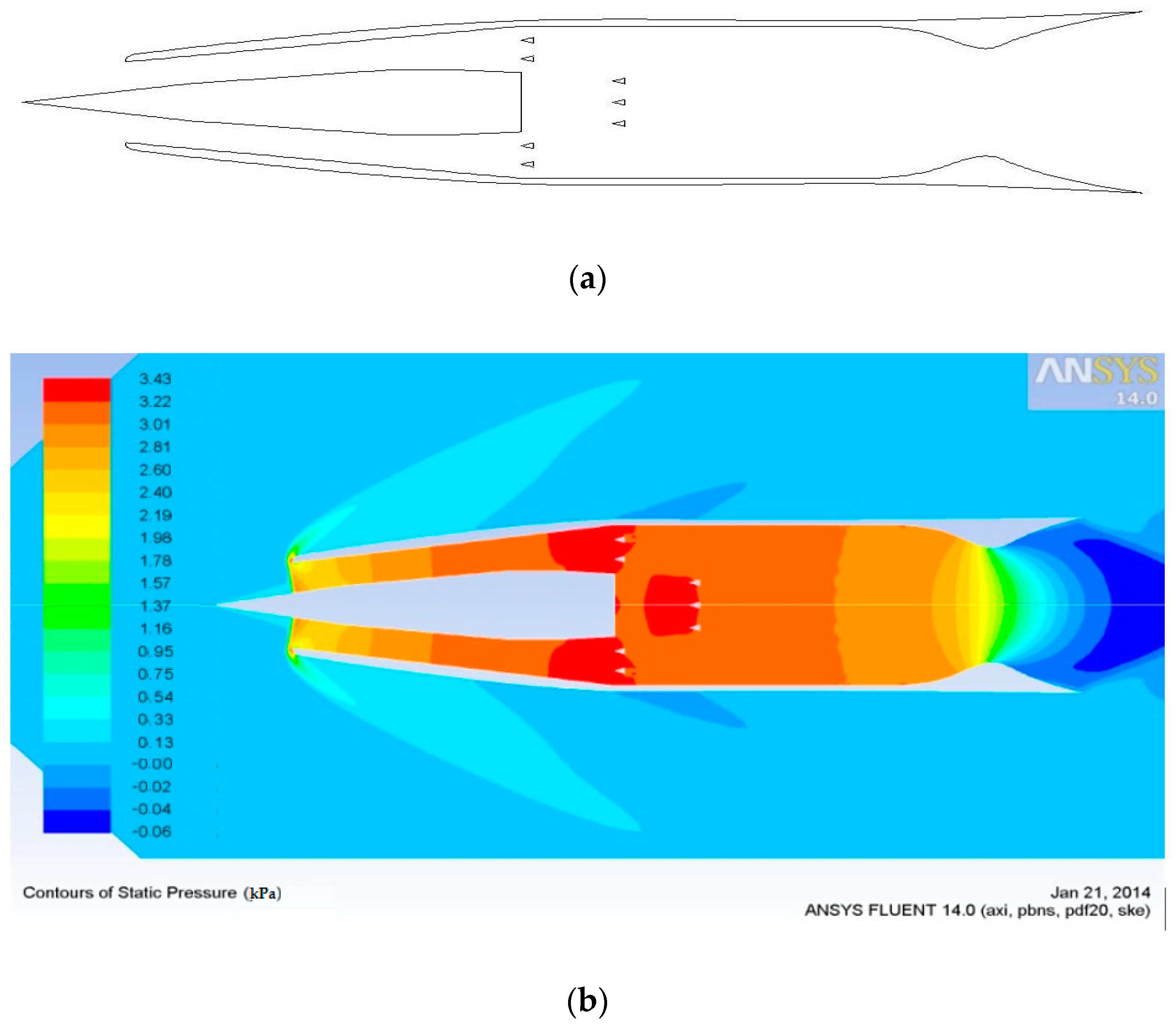
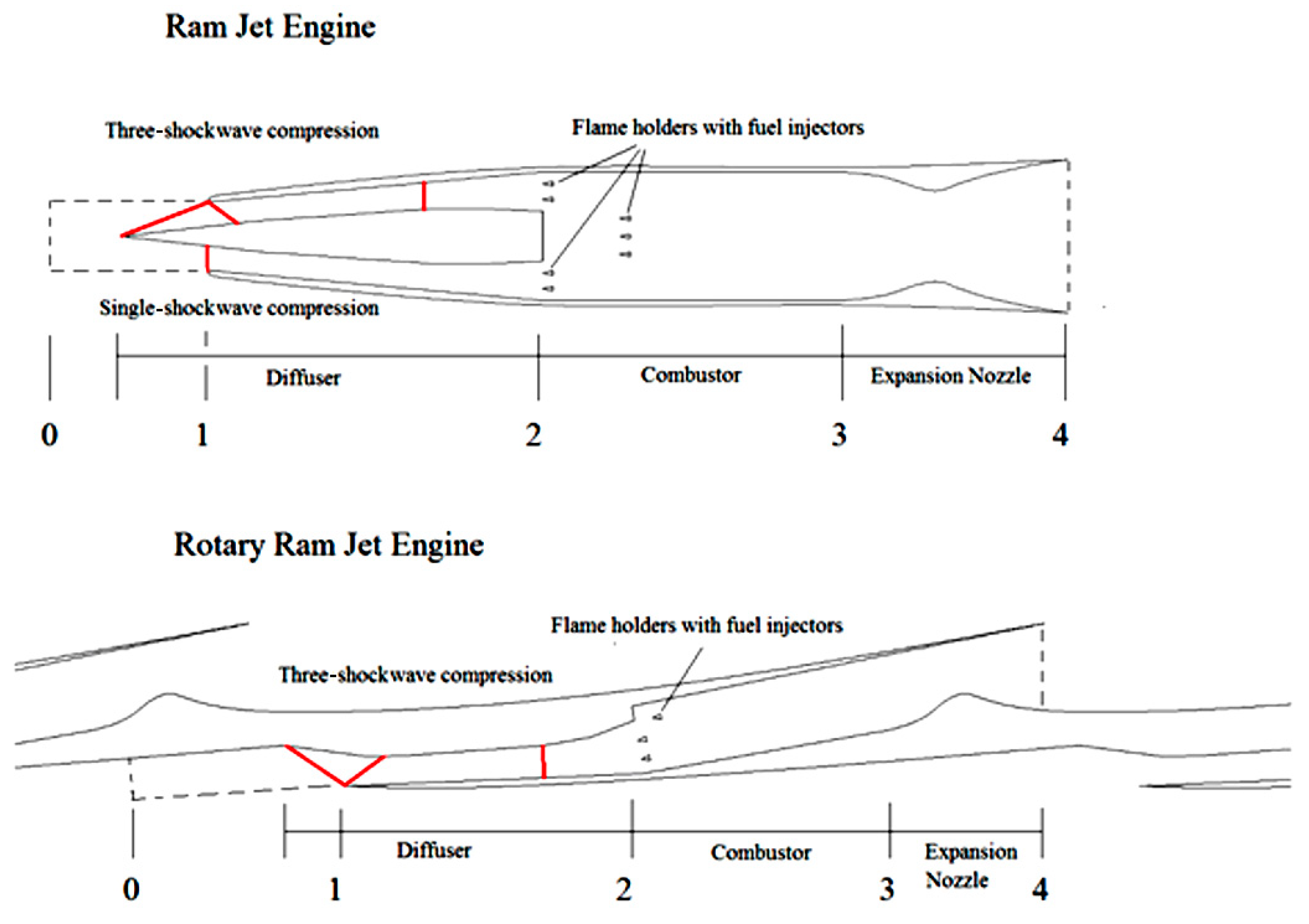
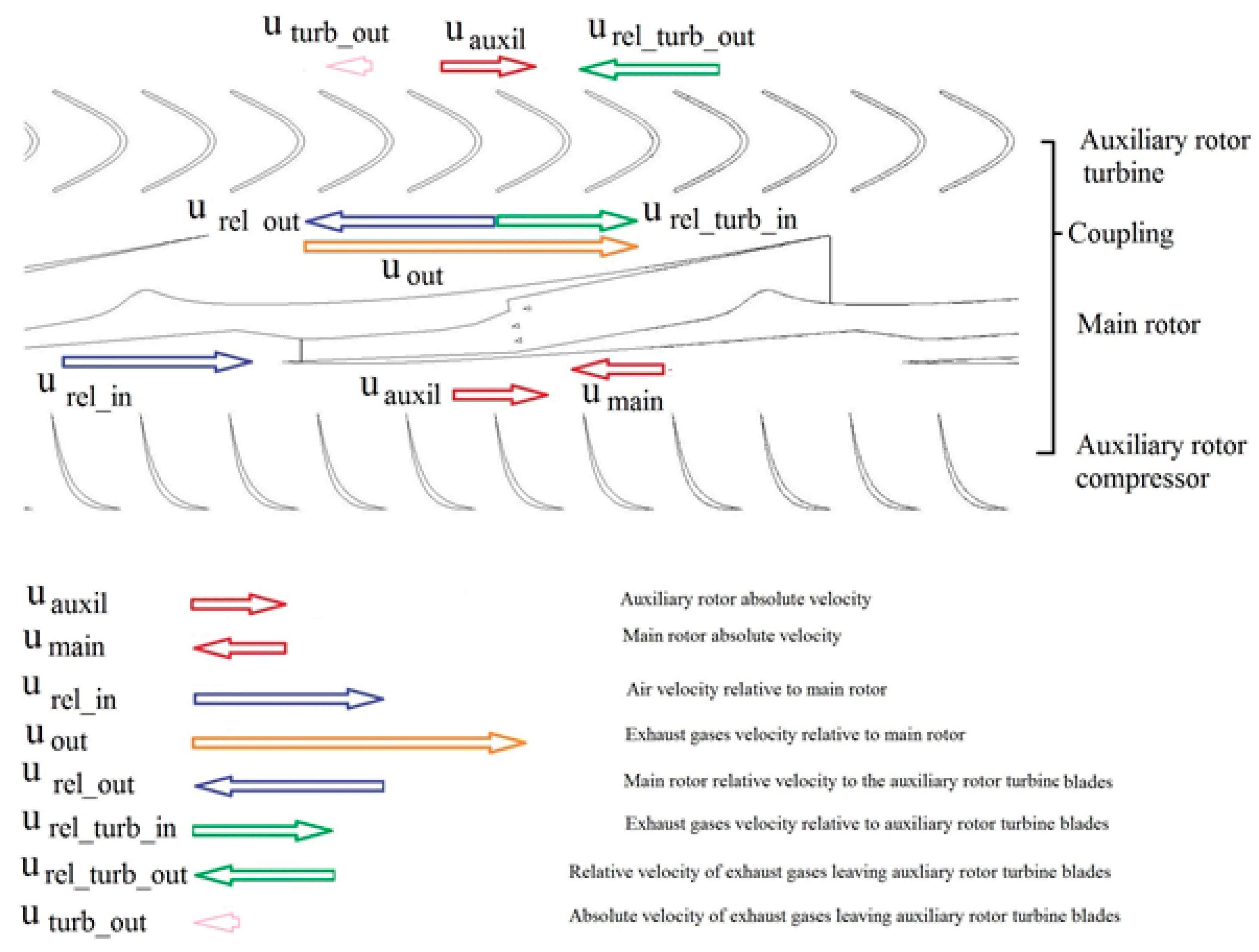

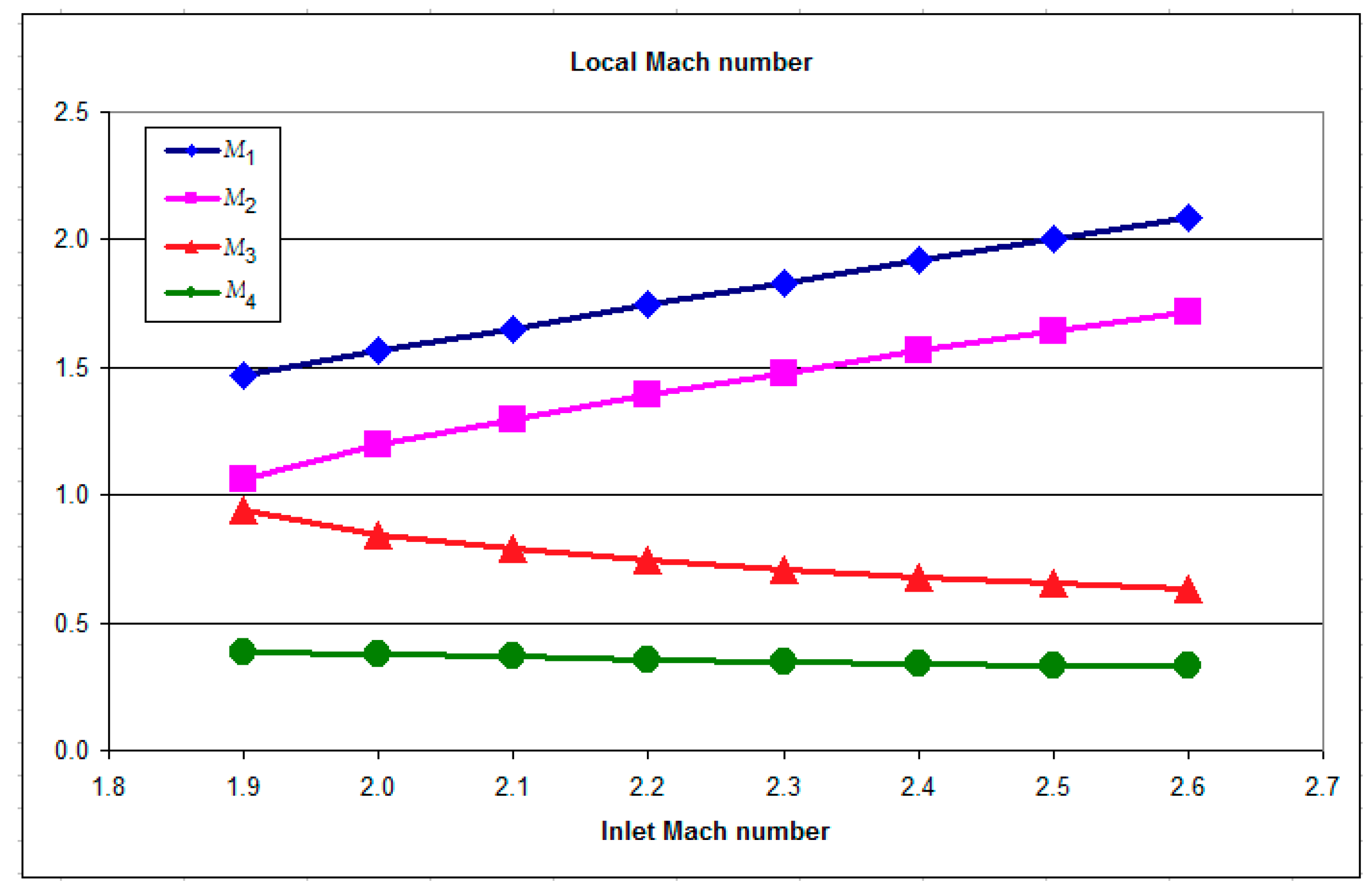
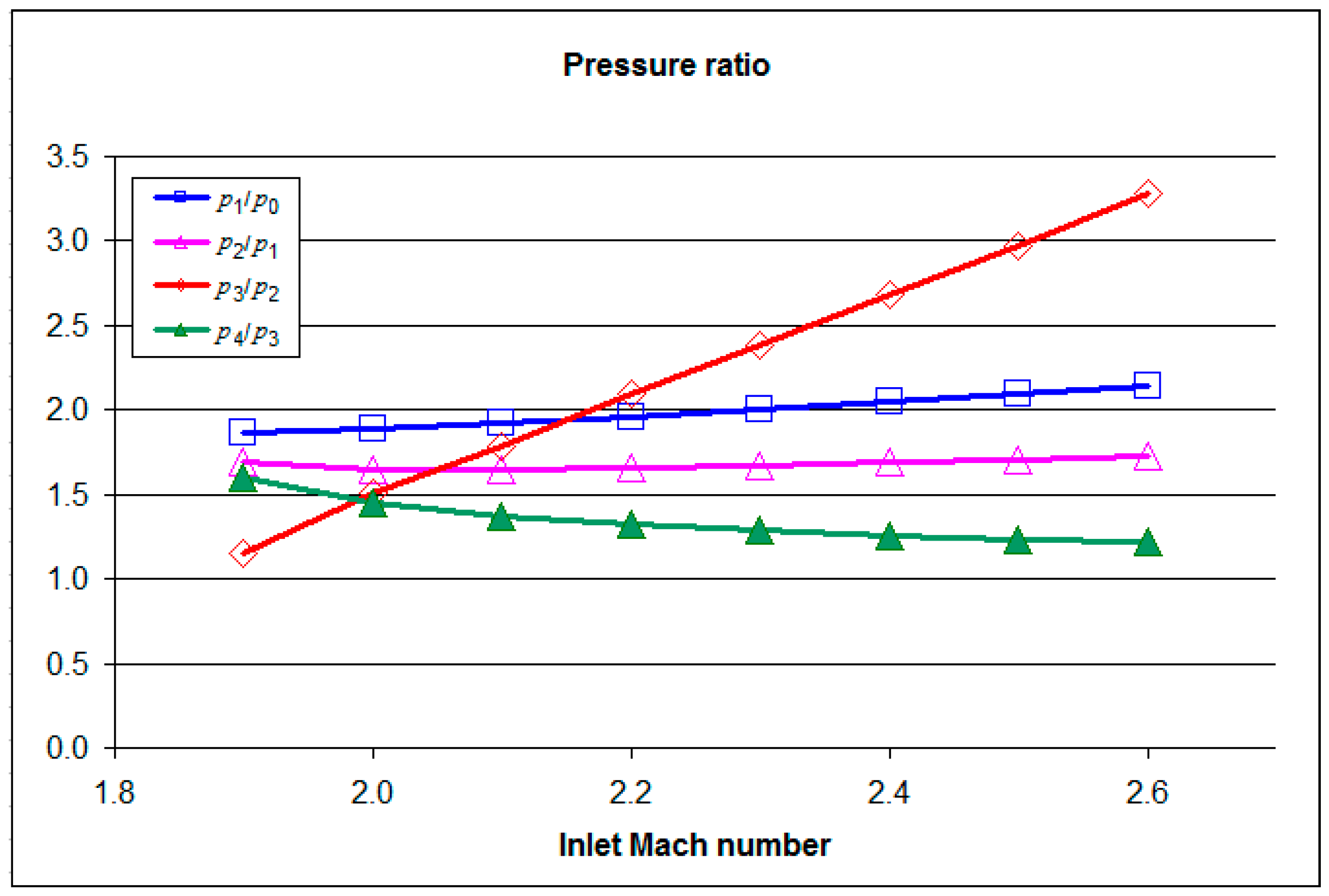
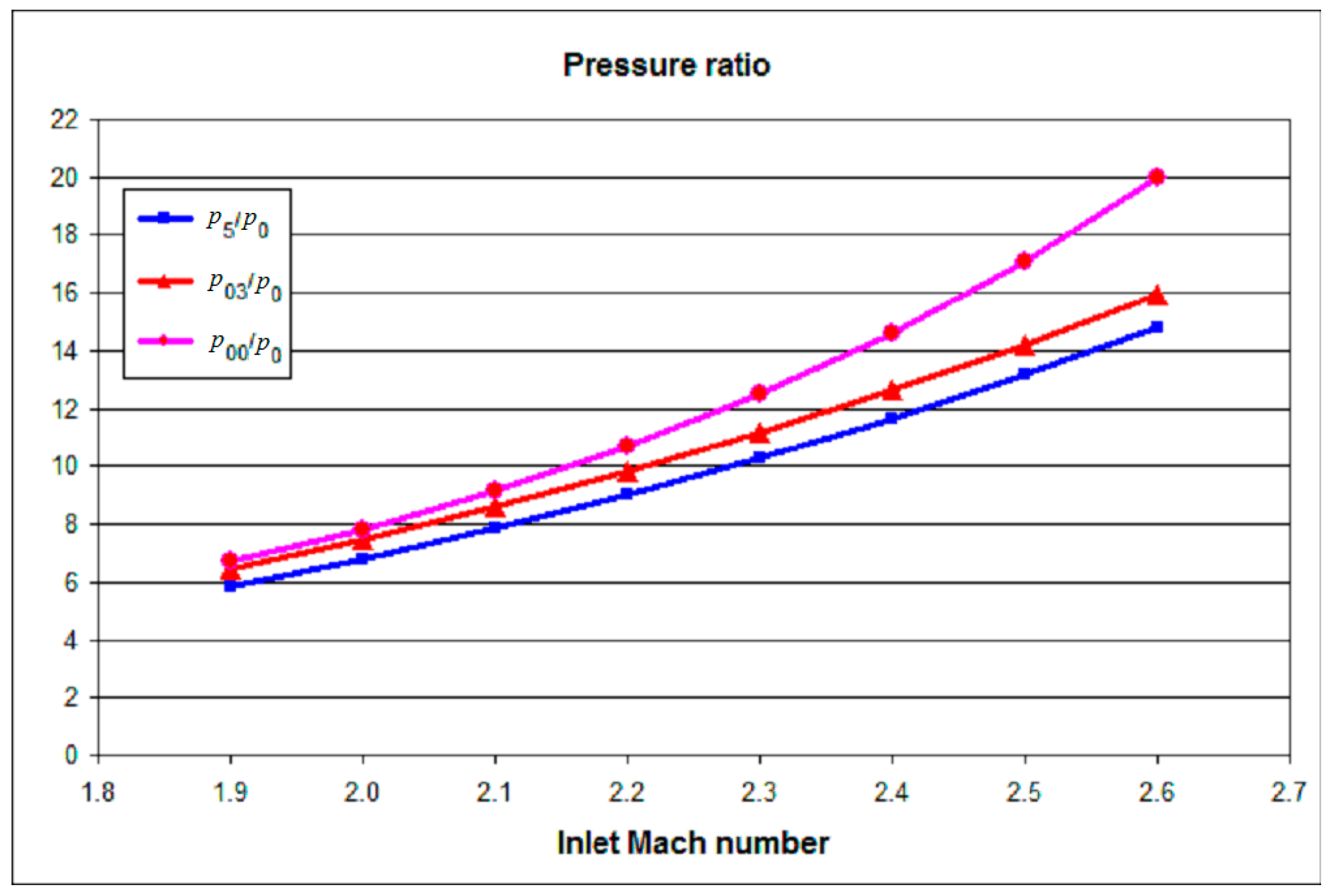
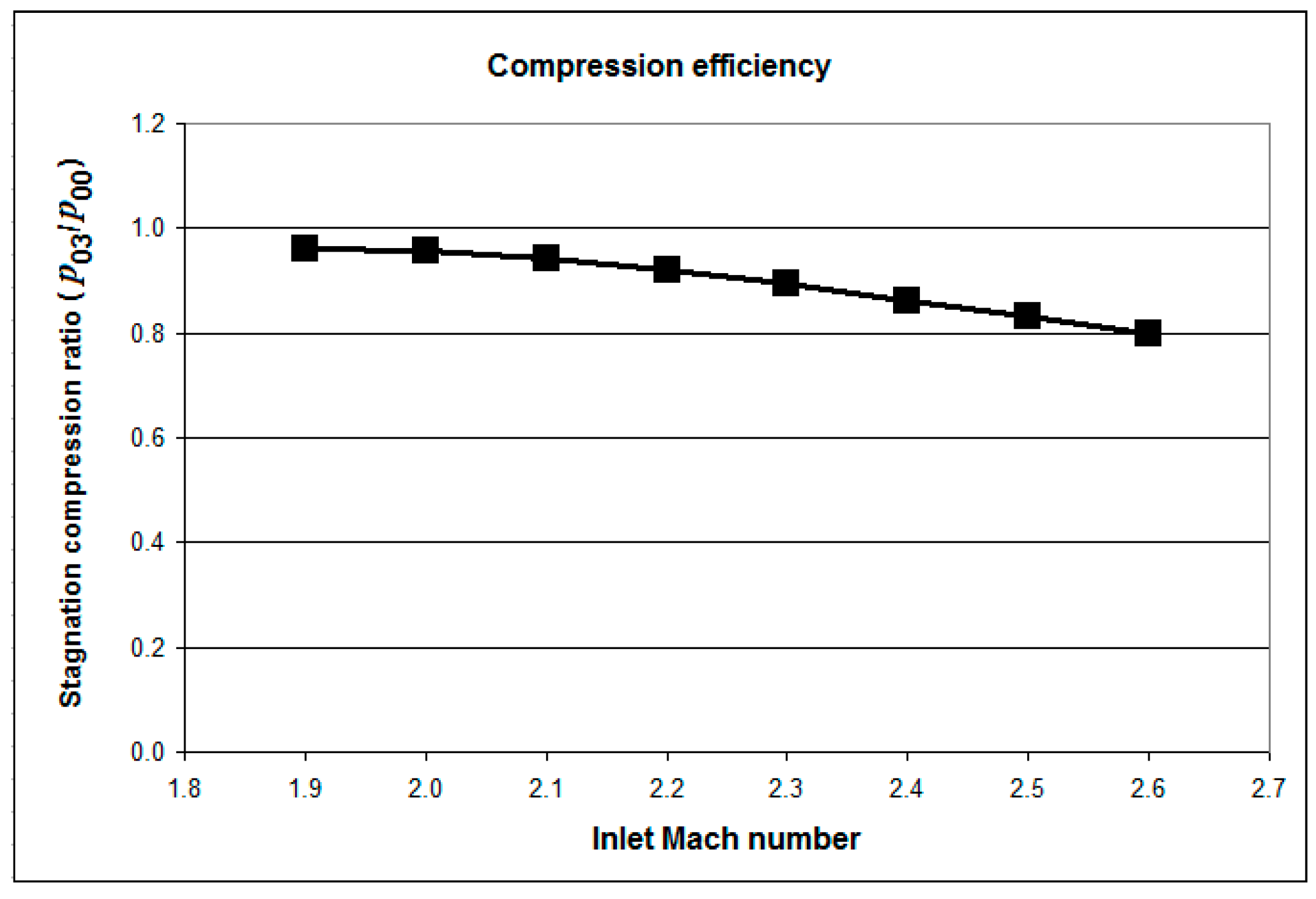
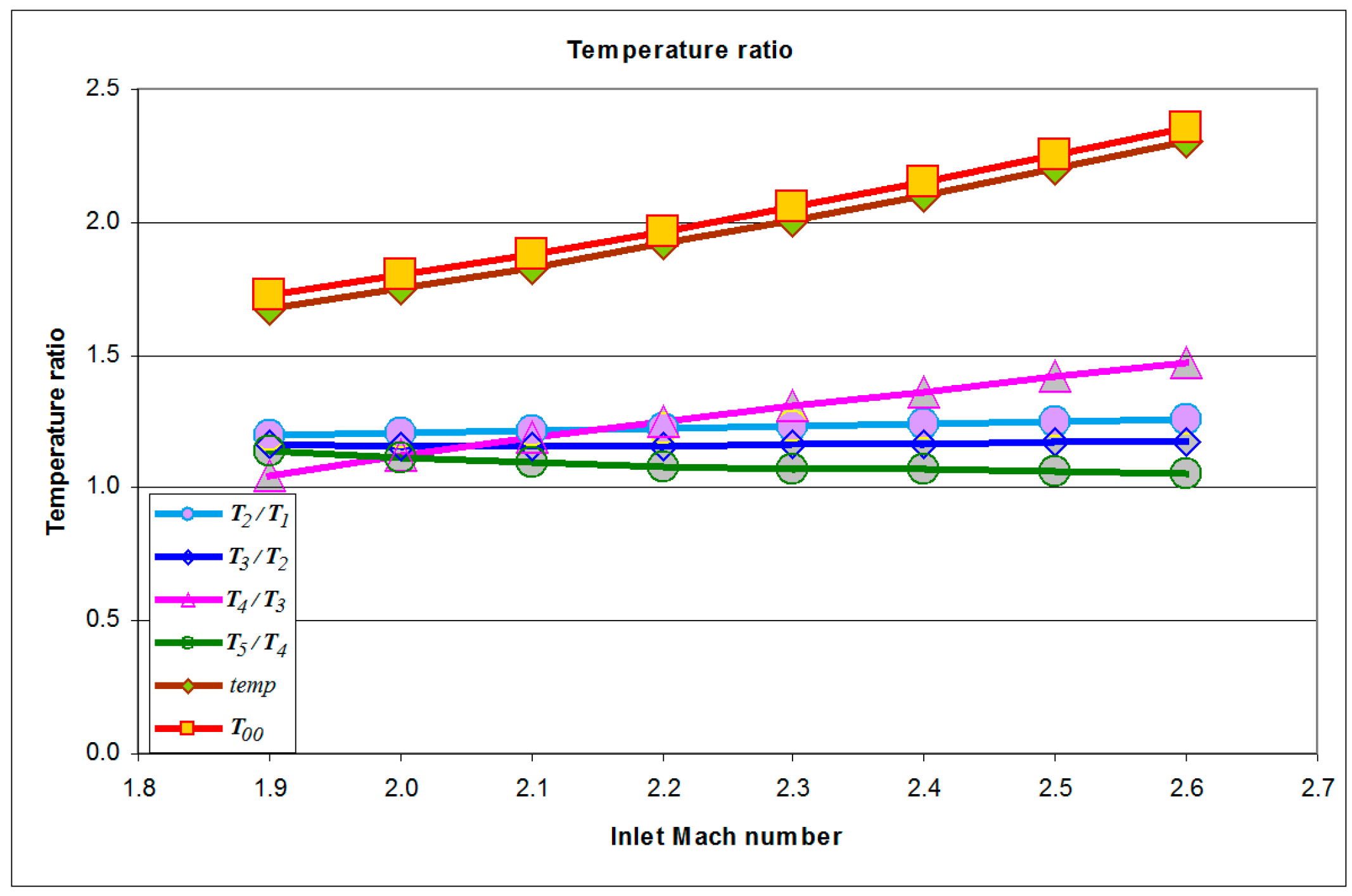
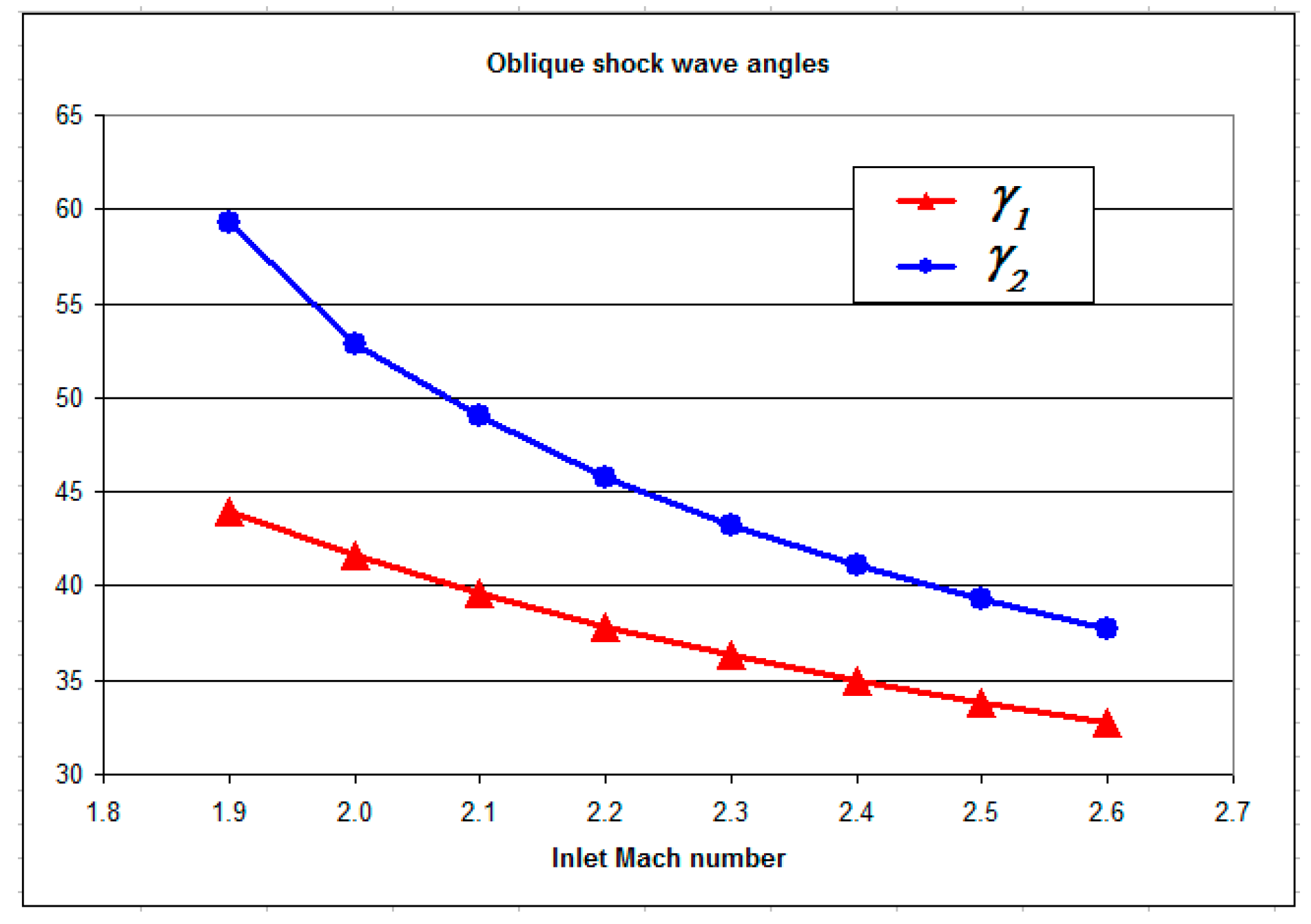
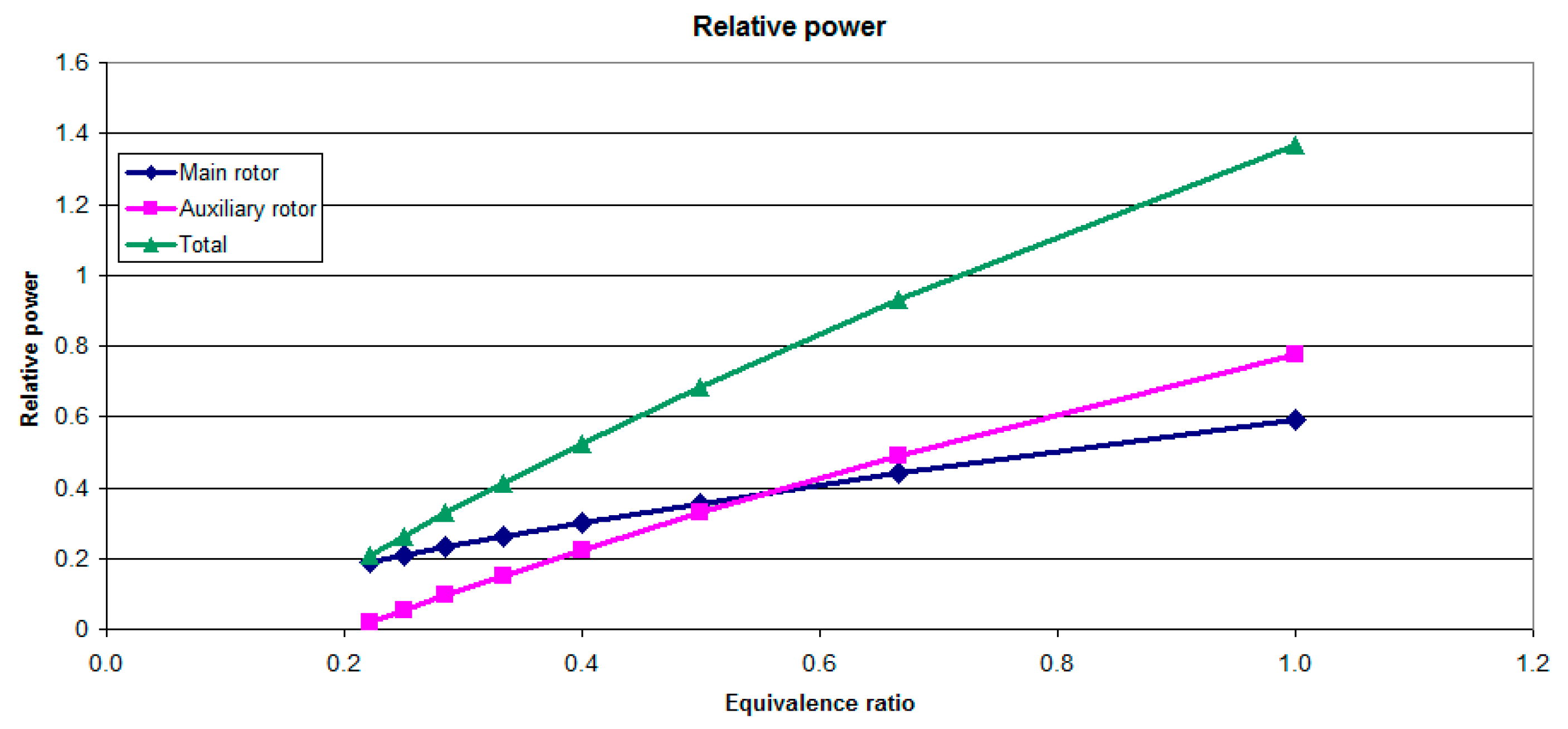
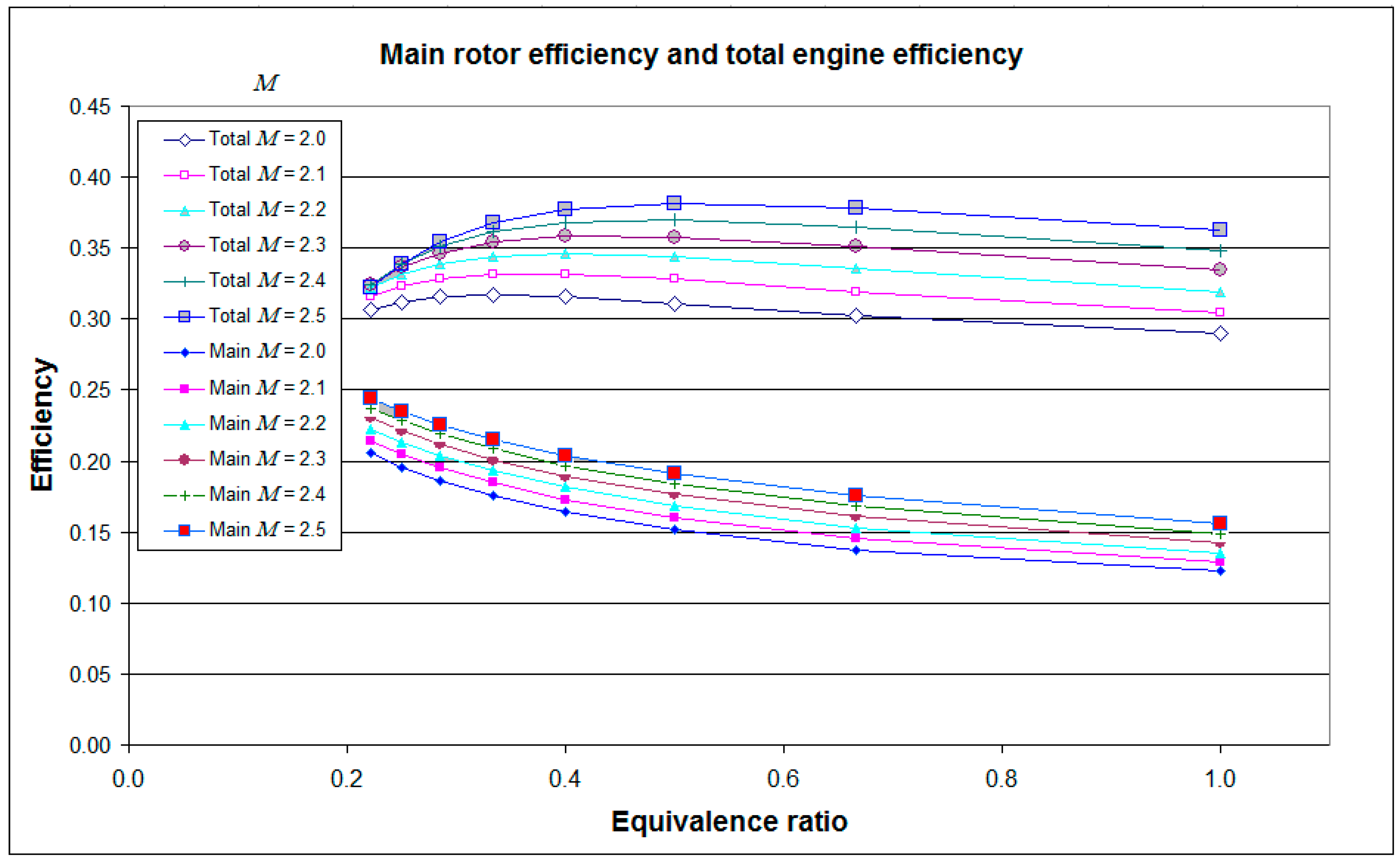

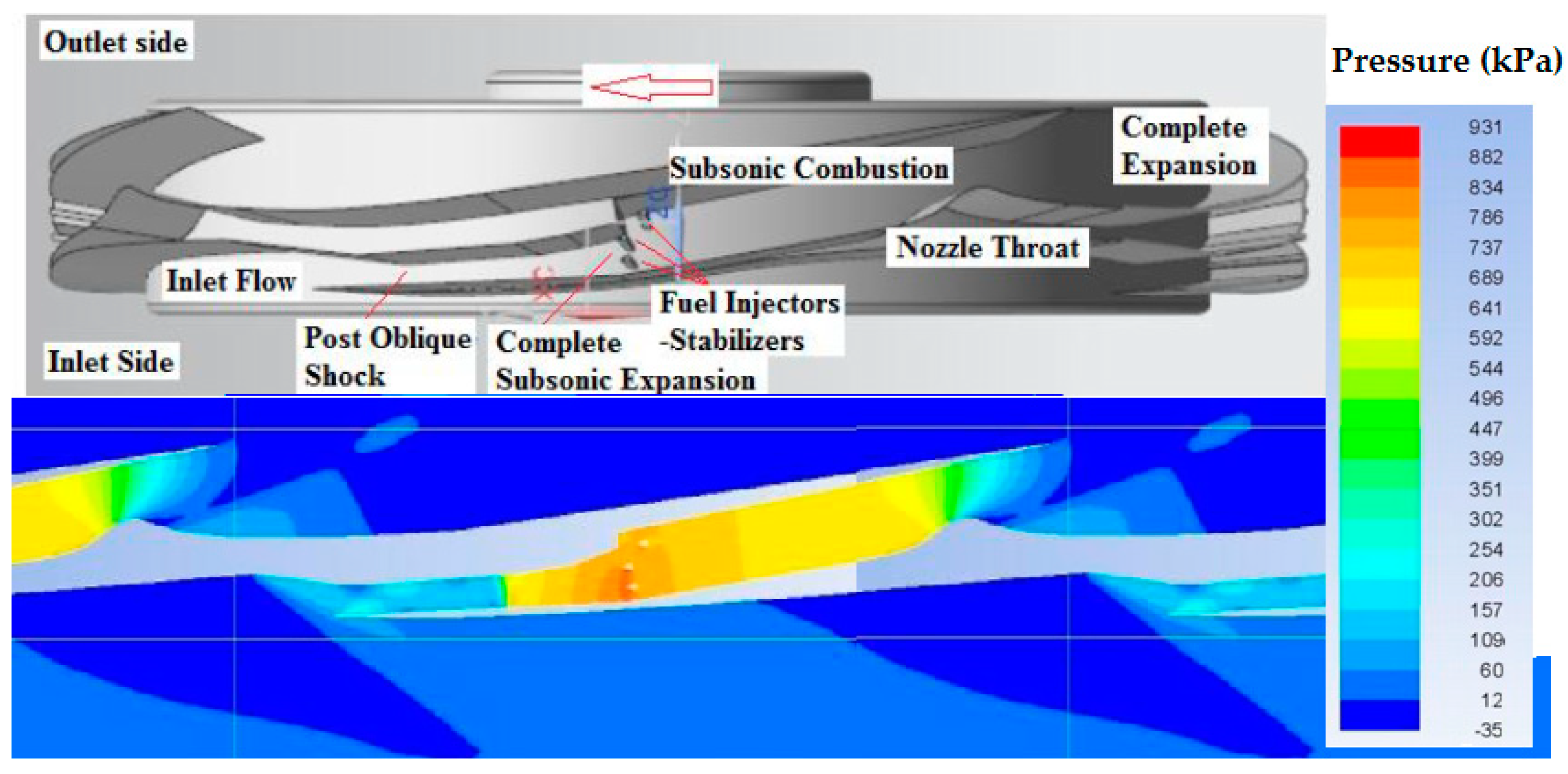
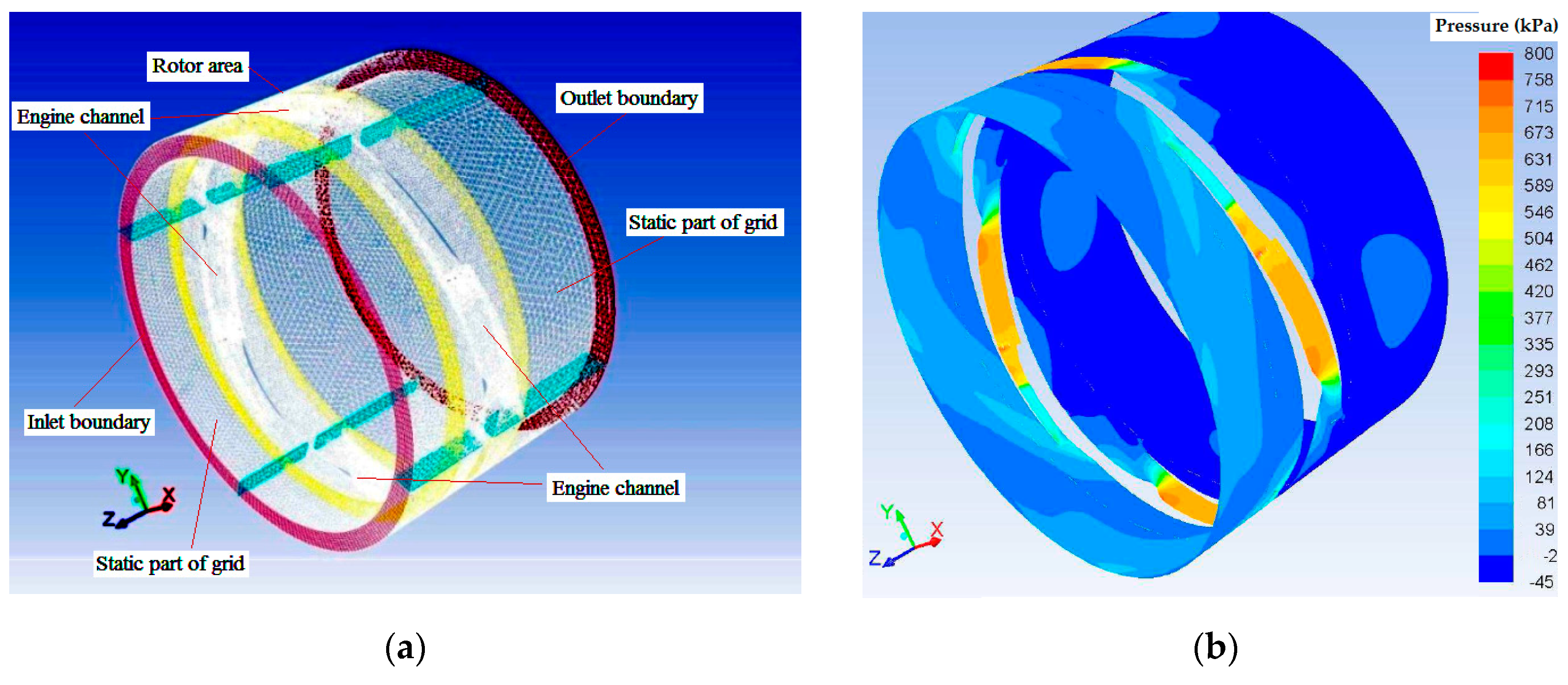
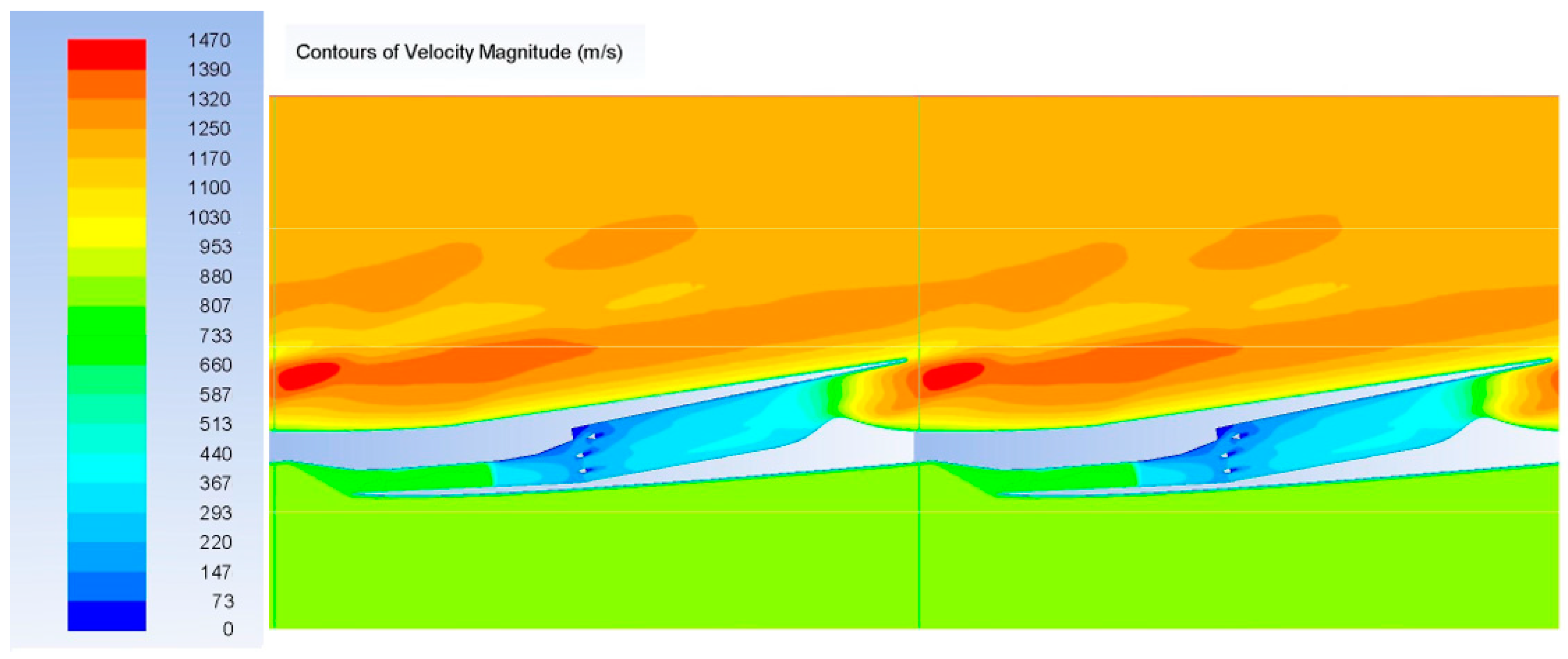
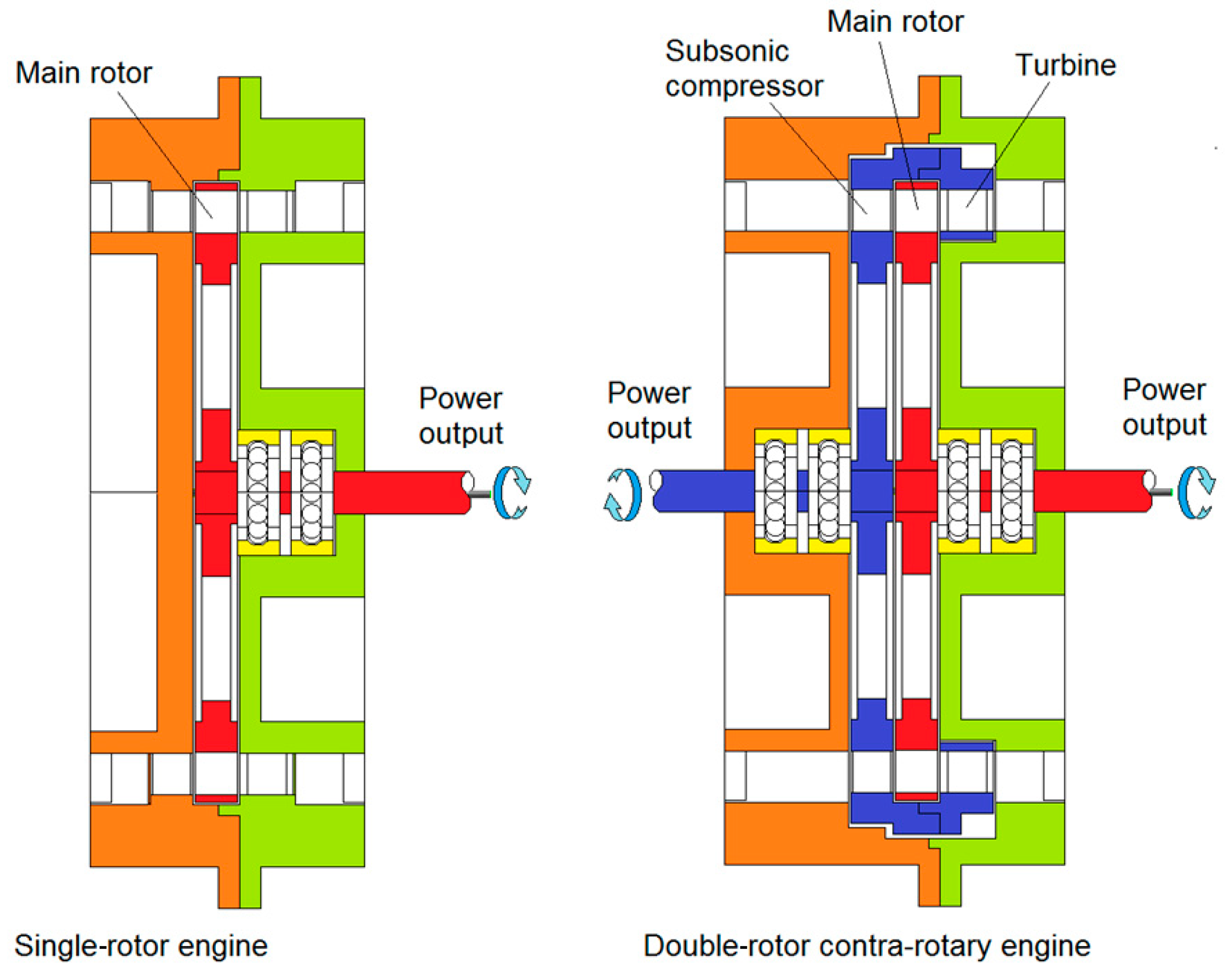


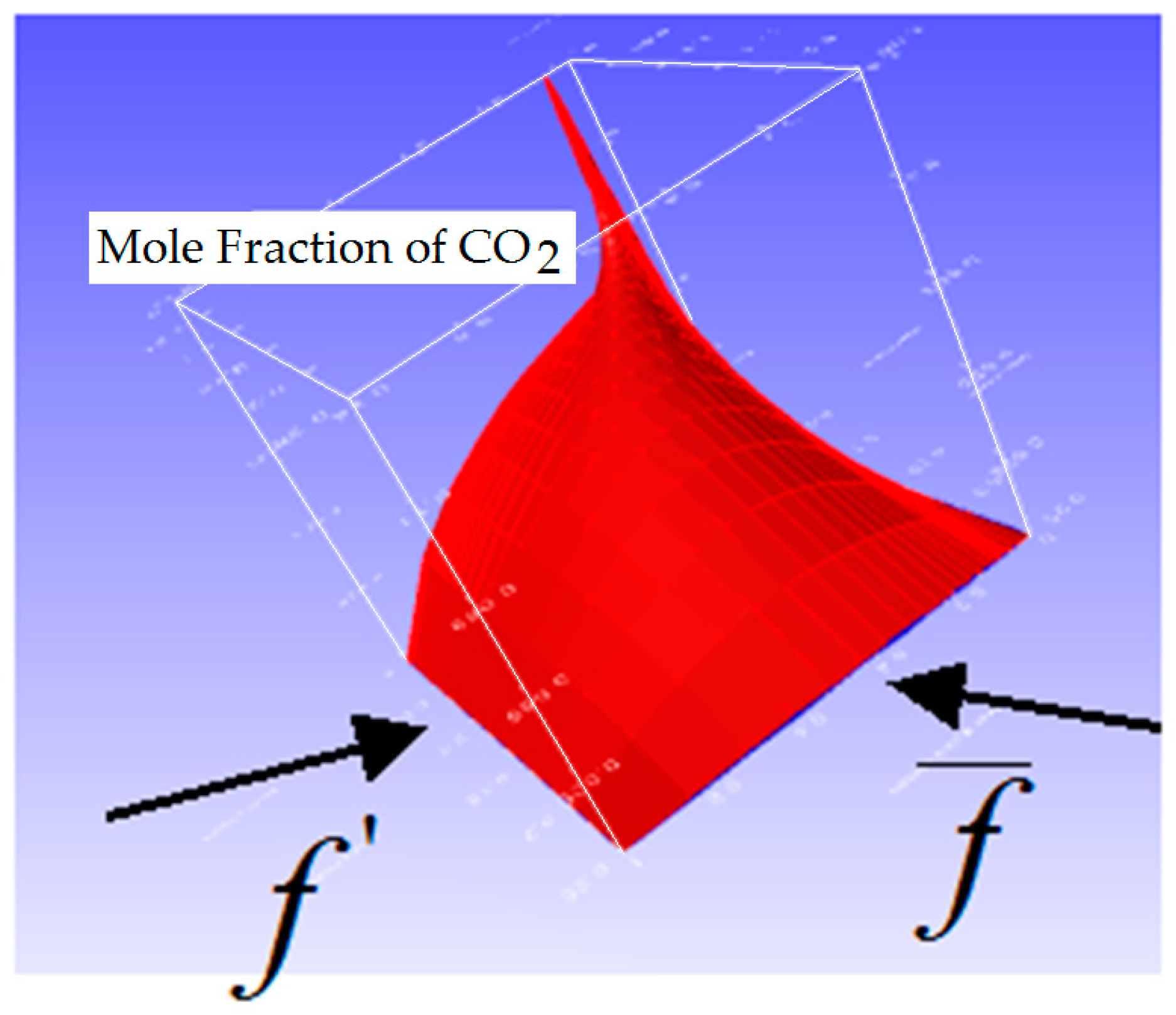
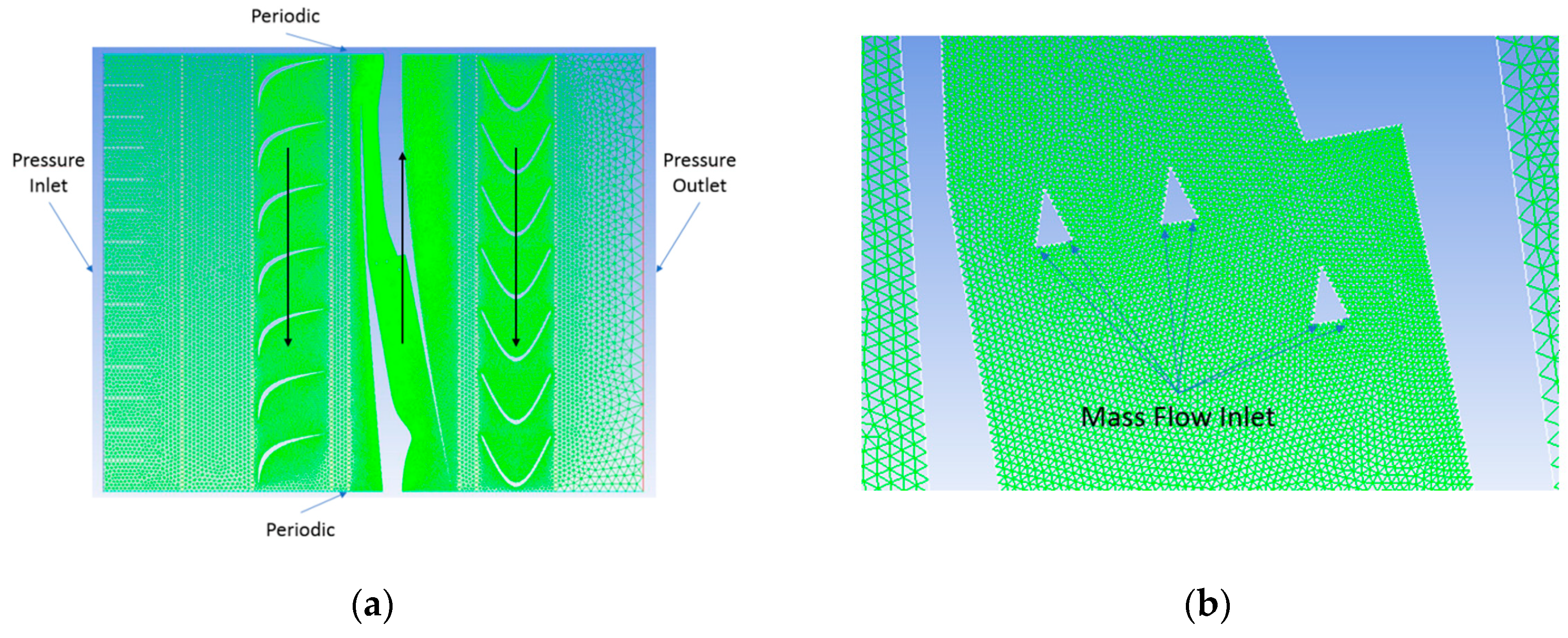
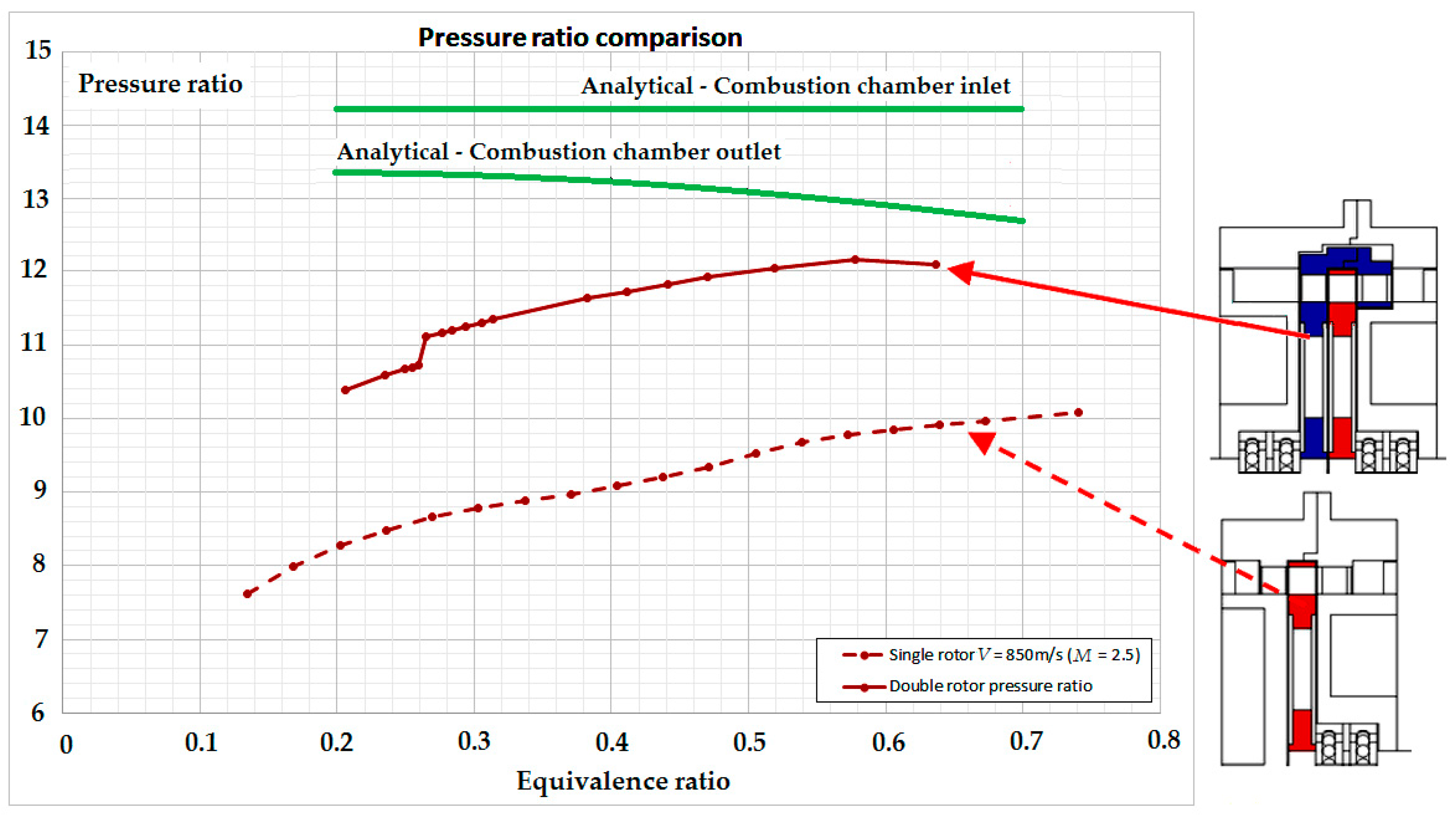
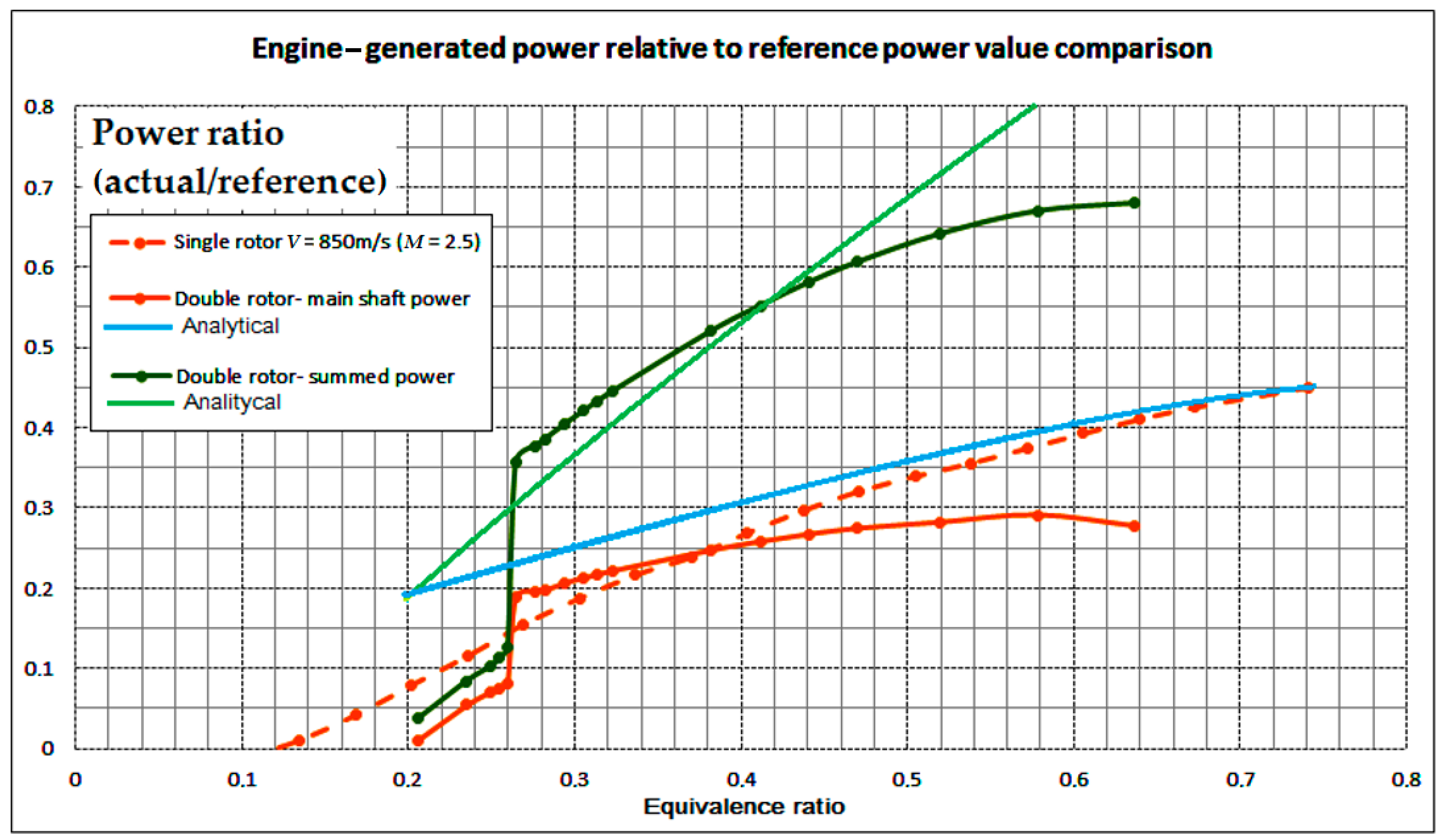
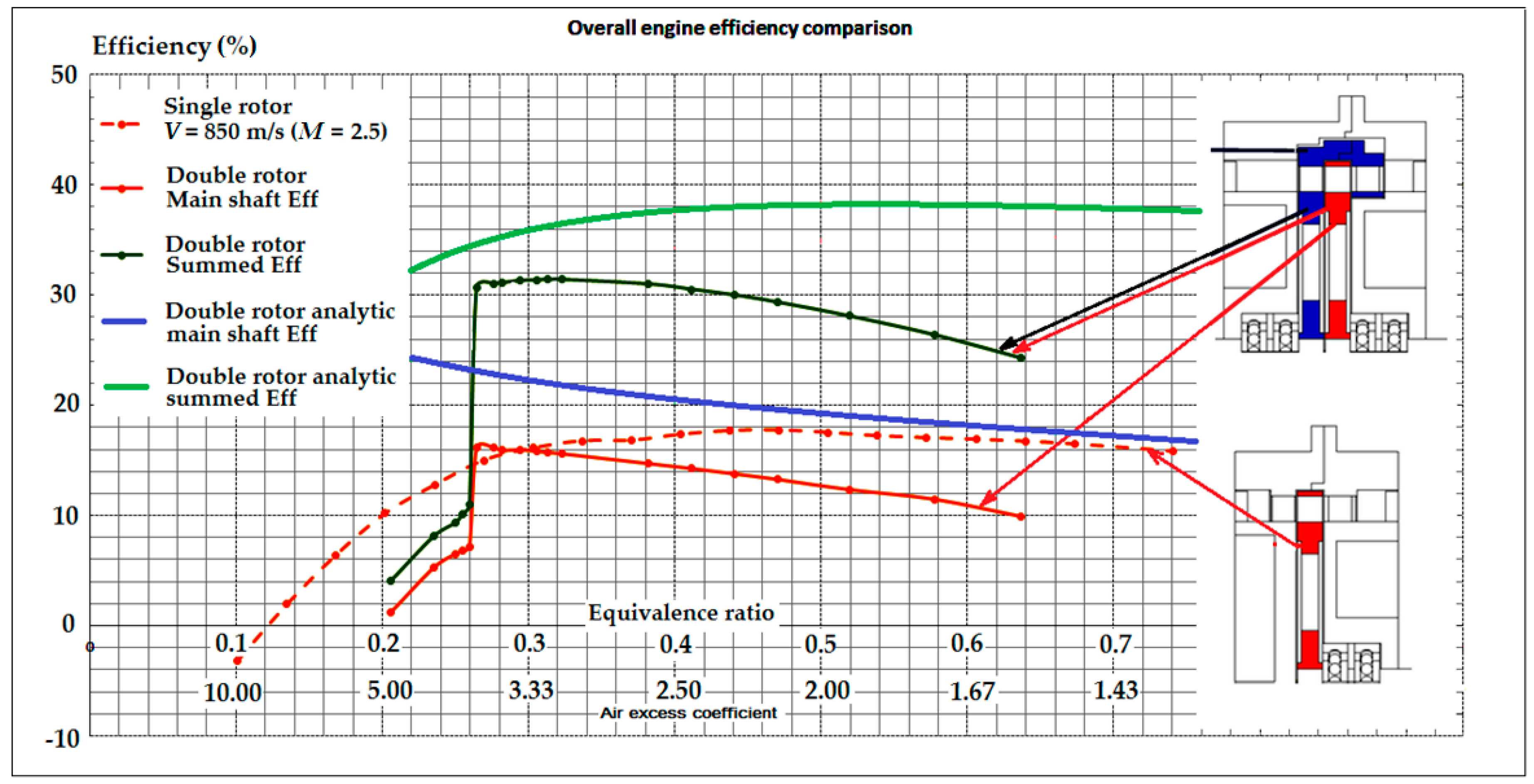
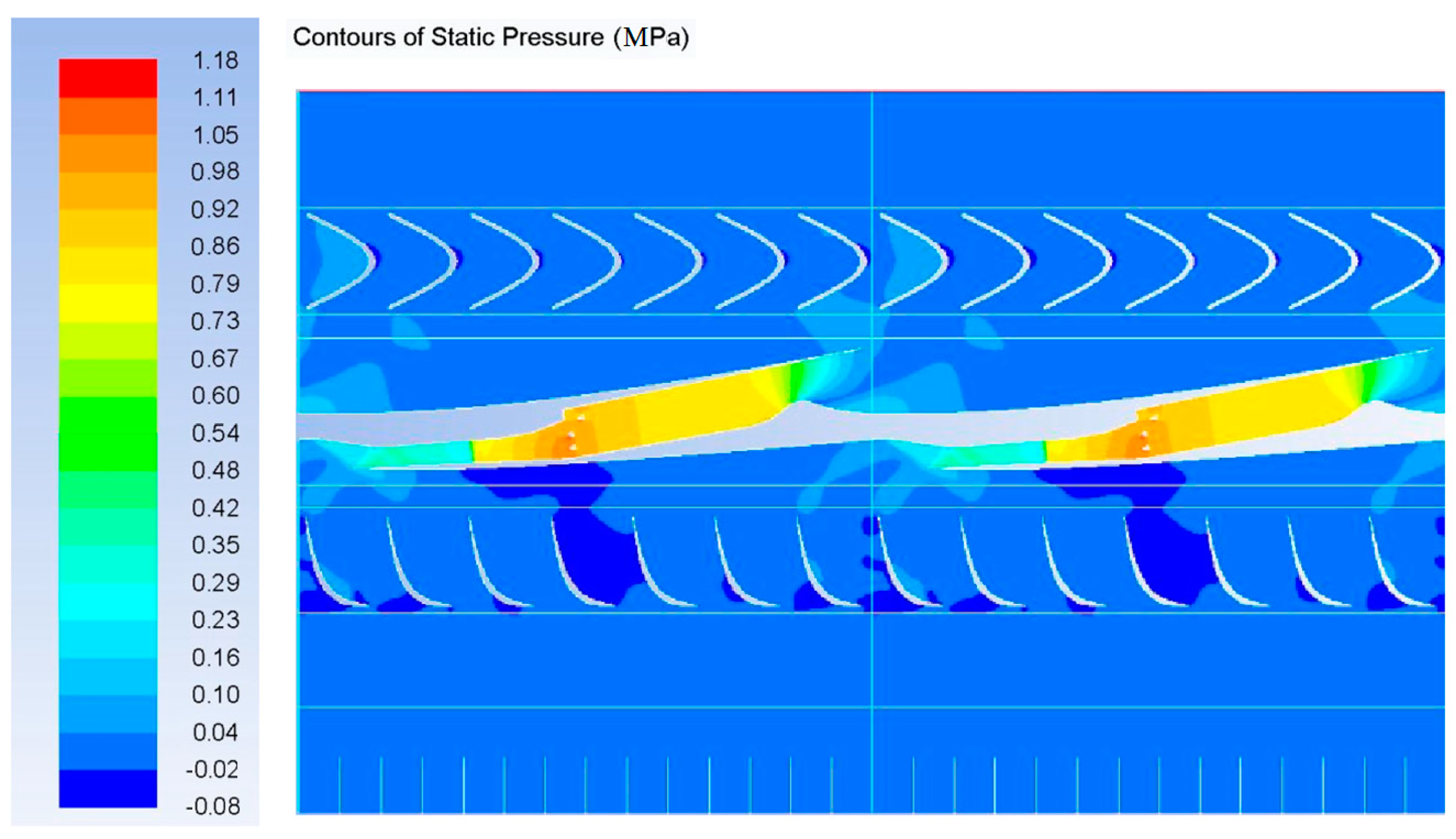
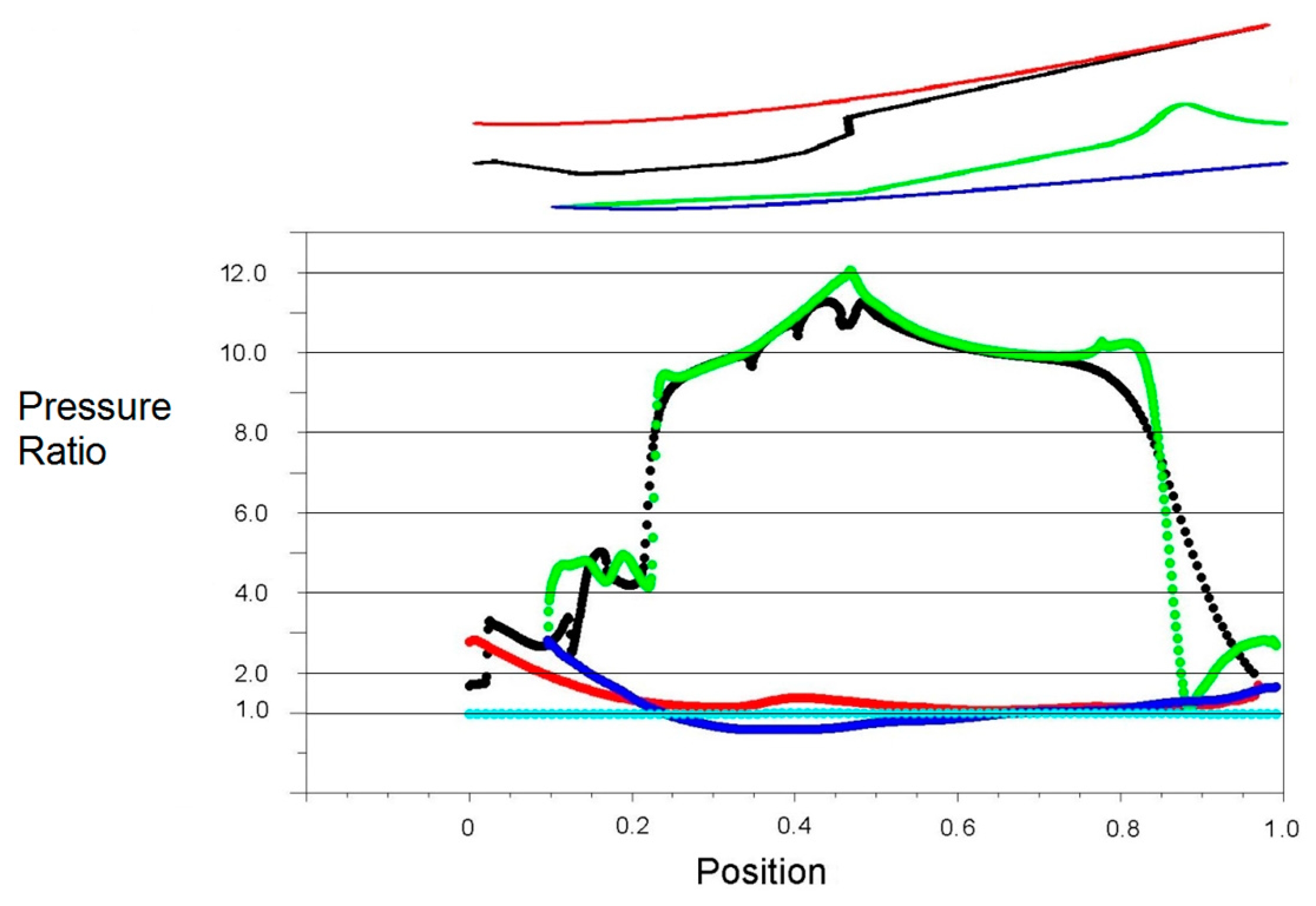

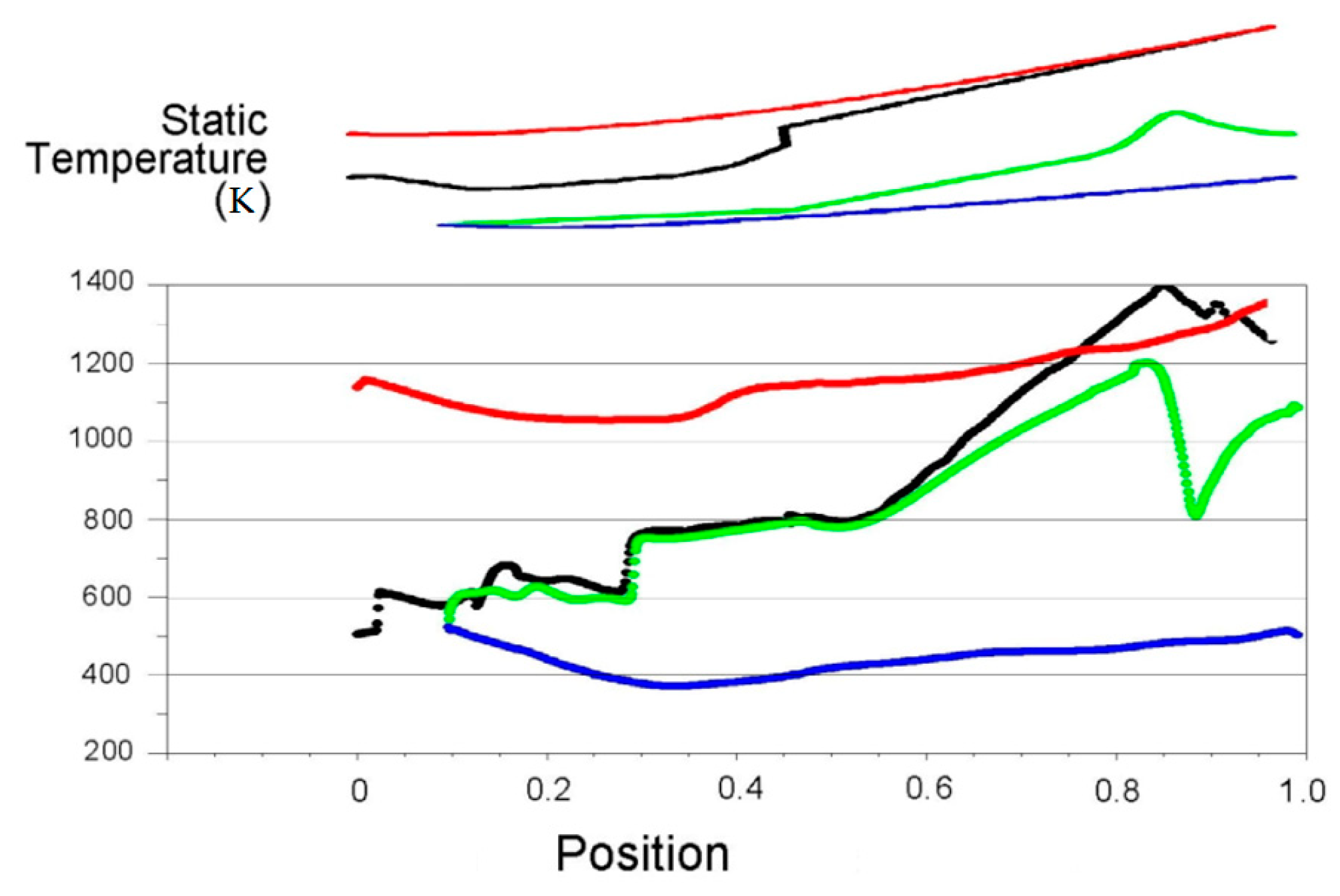
| Performance Parameter | Ramjet Rotor | Auxiliary Rotor | Summarized Performance |
|---|---|---|---|
| Rotational speed (rpm) | 15,915 | 15,915 | - |
| Excess air coefficient | 1.37 | 0 | 1.37 |
| Torque (Nm) | 108.7 | 108.3 | 217.0 |
| Power (kW) | 181.2 | 180.5 | 361.7 |
| Efficiency (%) | 15.73 | - | 31.4 |
© 2019 by the authors. Licensee MDPI, Basel, Switzerland. This article is an open access article distributed under the terms and conditions of the Creative Commons Attribution (CC BY) license (http://creativecommons.org/licenses/by/4.0/).
Share and Cite
Laube, T.; Piechna, J. Analytical and Numerical Feasibility Analysis of a Contra-Rotary Ramjet Engine. Energies 2020, 13, 163. https://doi.org/10.3390/en13010163
Laube T, Piechna J. Analytical and Numerical Feasibility Analysis of a Contra-Rotary Ramjet Engine. Energies. 2020; 13(1):163. https://doi.org/10.3390/en13010163
Chicago/Turabian StyleLaube, Tomasz, and Janusz Piechna. 2020. "Analytical and Numerical Feasibility Analysis of a Contra-Rotary Ramjet Engine" Energies 13, no. 1: 163. https://doi.org/10.3390/en13010163
APA StyleLaube, T., & Piechna, J. (2020). Analytical and Numerical Feasibility Analysis of a Contra-Rotary Ramjet Engine. Energies, 13(1), 163. https://doi.org/10.3390/en13010163






